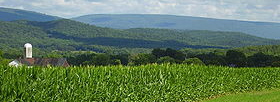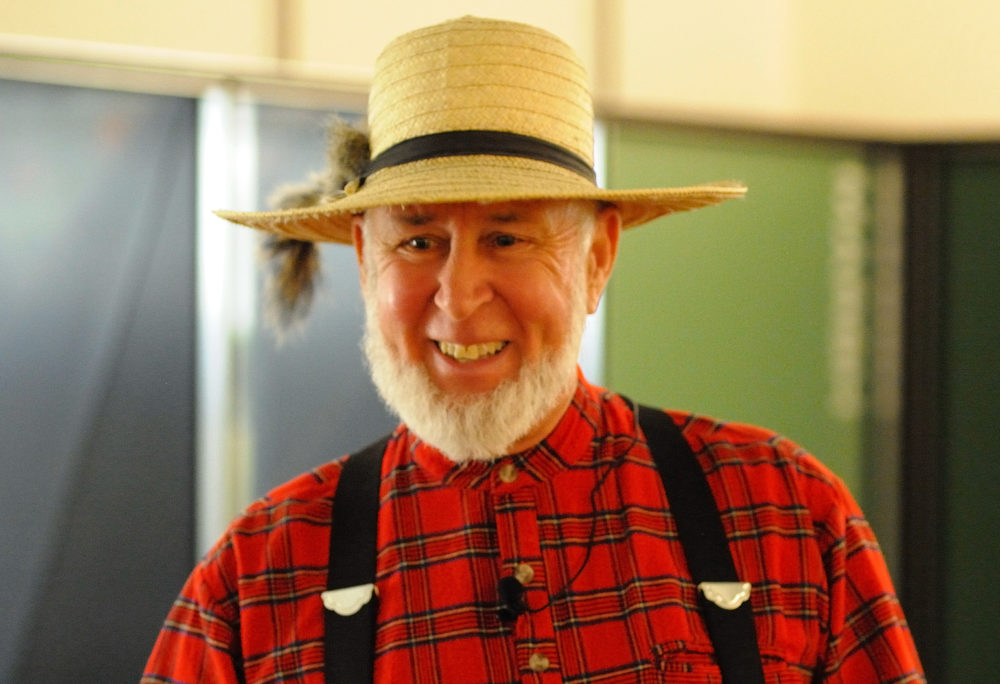Look at a map of the Juniata River valley of Pennsylvania. Do you see “Jack’s Mountain”, one of the main Appalachian ridges running south from Lewistown? Do you see “Jack’s Narrows”, a tortuous stretch of the river near Huntingdon? You might notice “Jack’s Creek” as well. Most likely about now you would be wondering just who was this man named Jack? It’s not an easy question to answer. In fact when it comes to Captain Jack, there are more questions than answers.
The man who became the legend lived in the valley during the days of the French and Indian War. Like most of the Scots-Irish settlers on what was then the Pennsylvania frontier, Jack had cleared some of the forest, built a cabin, and he and his wife were raising a family as they struggled to eek a living from the wilderness. But turmoil and violence were common to frontier life, as the various native-American Indian tribes sought to push back the ever-encroaching settlers who moved into their hunting grounds. In treaty after treaty, the proprietors of the Pennsylvania colony, the sons of William Penn, agreed to buy certain tracts of land. In treaty after treaty, it was usually promised that settlers would not be allowed to enter other tracts. But this latter promise was hard to keep. During these years of the 1750’s, many tribes, particularly the Delaware and Shawnee, had aligned with the French to push the “English” settlers back beyond the mountains. Many a cabin was burned to the ground, and the occupants killed or taken into captivity. Even the rude “forts” built by groups of settlers as a place of refuge were often overrun and destroyed by the French and Indians. But still the settlers came – the lure of land on which to create a homestead of their own was strong.
Jack was a big man, swarthy of color so the story goes, and he was an expert shot with the muzzle-loading flint-lock rifle so common on the frontier. He had “the eye of an eagle and an aim that was unerring,” so says McKnight’s history in “Captain Jack, the Scout.” Jack supplemented the meager crops he could grow with game from the forest. The family never lacked for deer, or bear, or turkey. Early one morning Jack took off on another of his frequent hunting trips. He often stayed out overnight, even in winter, thinking nothing of a night in the forest. Sometime in the spring of 1754, Jack returned home, lugging a good size deer he had taken, but he hadn’t even reached the clearing of his cabin when he sensed something was terribly wrong. Year round, a fire was kept going in the cabin’s fireplace, either for cooking or for heat. But the fire smell was too strong. Jack dropped the deer, checked to see his rifle was primed and ready to fire, and moved swiftly to the edge of the clearing. His cabin was a smoldering pile of logs. His few cows were not in the pasture. Jack watched, knowing that Indians has raided his home, to make sure that the invaders had moved on. As soon as he was sure, he rushed to the house. In spite of the fire, Jack found the dead bodies of his good wife and their two children, in amongst the charred timbers.
Jack raised up and screamed a scream of rage that must have been heard for miles down the valley. Then and there he swore revenge upon the Indians, and for the rest of his life he had only one purpose. That was to kill any Indian whom he could find.
He knew the trails and paths of the forest and the river valley as well as you or I know our neighborhood. He also knew the paths that Indians traveled in their journeys, and he made it a point to be along those ways. From a quarter-mile away, Jack’s rifle would speak, and an Indian would have paid the price for the killing of his family. Unusual for the frontier, Jack had a double barreled rifle. Reloading a muzzle-loading rifle took time. Jack surprised many an indian foe with that second barrel. After shooting, Jack would simply disappear back into the forest before others could find him, so that he could strike again another day. The “Black Rifle” he was called, for the dark color of his flintlock. The “Black Hunter of the Juniata” he was called for his dark complexion and thick black hair and the darkened buckskins he wore to blend in with the forest. Most often, Jack traveled and did his quiet work by himself, but he raised a group of other valley men who had lost loved ones to Indian raids. His leadership of this band perhaps accounts for his title of “Captain”, as there is no other record of a military service. Jack and his band were known and feared by the Indians, and rightfully so.
In the spring of 1755 a British army under the command of General Edward Braddock was on the move west through Pennsylvania. Their mission was to capture Fort Duquesne, the French stronghold on the site where Pittsburgh now stands. Braddock was accomplished on the battlefields of Europe, but knew nor appreciated little about fighting in the dense forest of Pennsylvania. Another part of the saga of Captain Jack is that he offered the services of his band of woodsmen to Braddock, but was haughtily refused. Braddock preferred his fancy troops and Highlanders to these crude and uneducated backwoodsmen. This story is reported by none other than the well known George Croghan, frontier trader and mediator of Indian affairs, but historians argue about the whens and wheres of his story. Suffice it to say, that if Jack and his men had been in the vanguard of Braddock’s army, many would have lived to report a grand victory over the French, rather than lying in unmarked graves in an endless forest.
This account of Captain Jack offering his services to General Braddock and being harshly rebuffed is repeated in almost all accounts by various writers, including Washington Irving in his “The Life of George Washington.” It must be noted that there is no actual written historical record, including in Washington’s diaries, of this event.
So Jack continued his pledged campaign against the Indians. Many an other pioneer settler told of hearing a gunshot outside his cabin, and of opening the door to find an Indian warrior lying dead. At the edge of the clearing was the “Black Rifle”, who had saved their lives. One tale tells of him being captured by a war party of fourteen Indians. Several days later, Jack returned to his mountain cabin with fourteen scalps hanging from his belt. Over the years many more were the Indian scalps found tied to trees and bushes along the mountain paths. The eventual defeat of the French in 1763 ended the Indian terrors in the Juniata valley, and Jack lived to be an old man in his beloved valley. Yet another tale would tell us that Jack was finally captured and tortured to death by the very Indians against whom he had sworn to take revenge. All agree that he was laid to rest with his family on the long mountain that still bears his name, perhaps a more fitting tribute than a stone carved by man. Indians and whites alike also agreed that for many years his restless spirit roamed from his mountain to the Juniata, appearing most frequently at a spring that flowed from the mountain.
So who was this man called “Captain Jack.” One story holds that he was really Patrick Jack, an officer in the British Army who served on the frontier. History documents a Captain Jack Ashby, who was an officer of the Second Virginia Regiment and in truth accompanied the Braddock expedition. Another source identifies him as Joseph Ager. Noted Pennsylvania folklorist Henry W. Shoemaker identifies Jack as Jacob Swartz. Shoemaker’s story too tells of Jack’s family being murdered by Indians, and of his ever-after campaign of revenge. Some would argue that the mountain and the river narrows are named for Jack Armstrong, an earlier indian trader, but that is their story, not mine. The pacifist Quakers in the Provincial government in Philadelphia, referred to Jack only as “that bloody man.”
Historian Hervey Allen, in his novel “Bedford Village”, offers what may be the most extensive account, but that doesn’t mean it is true. Jack, says Allen, was born John Fenwick. As in other accounts Jack returns to his cabin one day to find his wife and children slain. After several weeks of trance-like wandering in his grief, Jack comes to terms with this truth. “From the time he recovered his memory after the massacre of his family until the cooling hand of old age fell upon him, he pursued one object, was possessed of only one mastering desire. The end, of course, was the extermination of indians. In that line he became both a hero and a genius.”
“He approached unseen,” says Hervey Allen, “struck and fled. He outran, outshot, and outdid his enemies in all things and particulars. His strength was gigantic and inexhaustible; his cunning and strategies innumerable and seldom repeated. Chiefs died, shot at the council fire. Young warriors, women, and children vanished. His name became a synonym for fatal misfortune. War parties were scattered in long and vain pursuits and were cut off individually as they turned back. In the end any who returned unscathed were counted lucky.”
The tales of this legendary frontiersman weave tightly around and about each other so that it is not possible to follow any single thread. The man in the legend may well have been more than one person in life. Suffice it to say that the “Wild Hunter of the Juniata,” embodied the courage and independence and resolve that marked those early colonists who took the westward path into the mountains beyond the Susquehanna.
The photo below shows the long unbroken ridgeline of Jack’s Mountain.

[ This story is based on information from several sources, which are listed below. ]
Sources: “Bedford Village”, novel by Hervey Allen, Farrar & Rinehart, Inc. New York, 1944; “Stories of Pennsylvania”, by Joseph S. Walton & Martin G. Brumbaugh, American Book Co., 1897; “The Indian Wars of Pennsylvania”, by C. Hale Sipe, 1931; “Tales of the Allegheny Foothills”, by Vaughn E. Whisker, published in the Bedford PA Gazette, date unknown, later published in Book Form; “The Life and Adventures of David Lewis the Robber and Counterfeiter”, Edited by C. D. Rishel, C.D. Rishel, Publisher, Newville, Cumberland County PA 1890 (Reprinted 1991 by Newville PA Historical Society); “The Romance and Tradgedy Of Pioneer Life, A Popular Account of the Heroes and Adventurers Who, By Their Valor and War-Craft, Beat Back the Savages From the Borders of Civilization and Gave the American Forests To the Plow and the Sickle”, by Augustus Lynch Mason, A.M., Jones Brothers and Co. Cincinnati Ohio, 1883, Copyrighted 1883 by J. T. Jones; “Juniata, River of Sorrows”, by Dennis P. McIlnay, Seven Oaks Press, 2003 “Old Fort Duquesne, or Captain Jack, the Scout”, by Charles McKnight, Peoples Monthly Publishing Co., Pittsburgh, 1873
